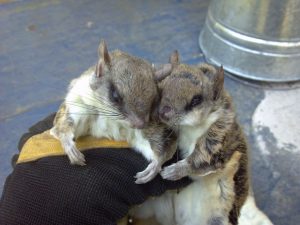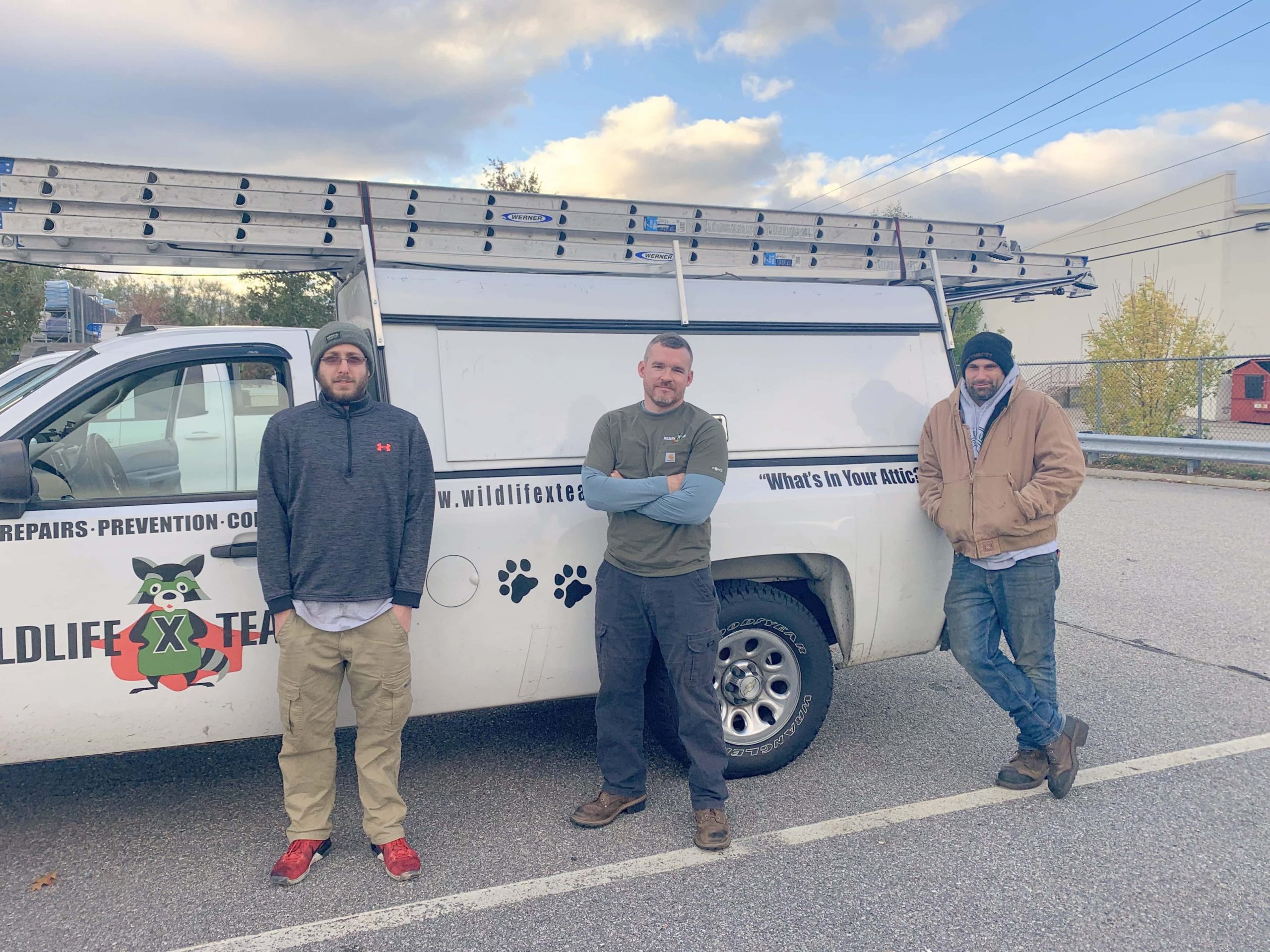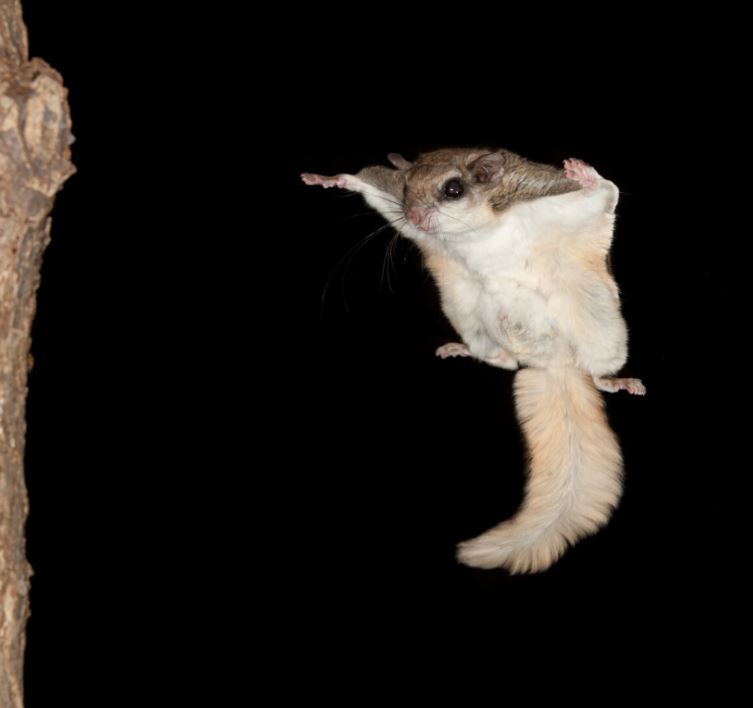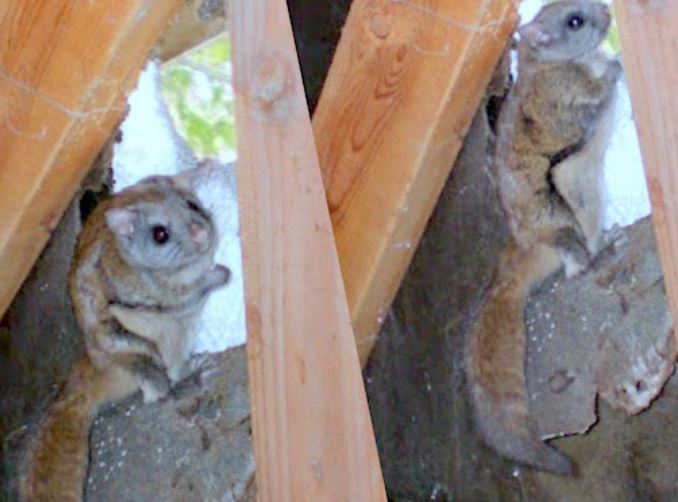Wildlife Removal New Hampshire

Call for Your Exclusive Wildlife Inspection Report.®
FLYING SQUIRREL REMOVAL
Flying squirrels are cute mammals. They have a skin flap that attaches their fore and hind limbs, causing them to glide from tree to tree and from trees to houses. Flying squirrels are cousins to conventional squirrels, and their population is increasing exponentially. Flying squirrels do not actually fly, but glide around with the assistance of their special skin flap.
WHAT HARM DO FLYING SQUIRRELS CAUSE?
Flying squirrels are cute and unique, different from other squirrel species, but you will find that they are not fun to have in your home or yard. They are harder to deal with if they invade your home.
Their small structure shouldn’t fool you into believing that they are harmless. They are capable of damaging your yard and home. These pests have a reputation for stripping off the bark of large trees and destroying sapling trees.
Flying squirrels dig holes in the yard to search for food and eat the vegetables and fruits in your garden. When they get into your home, flying squirrels will nest in the attic and walls, gnaw through the wiring system and plumbing works, and eat wood and furniture in your home.
Flying squirrels living in your space put you in danger as their nests are very combustible, and all it takes is one spark to set your entire home aflame. Flying squirrels also leave behind their feces and urine that cause respiratory problems if you do not seek professional assistance in their removal and relocation. These critters also carry diseases like rabies and typhus. They will readily spread these to you and your pet animals if you do not keep them in check or remove them from your yard.
FLYING SQUIRREL EXCLUSION
Flying squirrels are harder to remove because of their ability to glide from tree to rooftop. However, the best way to remove flying squirrels from your yard or home is probably by removing their food source. When there is no food supply in your home for them, the flying squirrels do not have any reason to stay, and so they move on to other places.
You can eliminate flying squirrels by observing simple sanitary practices like keeping the yard free of food debris, clearing overripe fruits, storing food properly, avoiding a buildup of debris, feeding pet animals indoors, and so on. These practices will keep your home safe from wildlife pest infestations.
If the flying squirrels are yet to infest your home, you could make fences around your home though this might be somewhat ineffective because of their ability to glide. However, you could cut tree branches very low so that they will be unable to glide from the tree to your rooftop and into your house.
The professionals at Wildlife X Team New Hampshire are always ready to offer assistance and professional advice to you concerning the prevention of a flying squirrel infestation.
FLYING SQUIRREL REMOVAL
Having a flying squirrel infestation problem can be really annoying to the homeowner, and humane trapping is the safest choice of removal. There are various trap options for trapping a flying squirrel, but you must ensure that your state laws permit the capture and relocation of flying squirrels. Use their favorite snacks like peanut butter or cheese as bait for their capture, after which you can transport the squirrels about twenty miles from your home and leave them at locations where they are free to express innate behaviors without being a nuisance to anyone.
Instead of worrying over the details of flying squirrel removal, you can contact the professionals at Wildlife X Team for help. We have professionals with animal removal experience, expertise, and the right equipment for flying squirrel removal. We also offer other services like litter removal, attic cleaning and sanitization, damage repair, and professional advice.
Get Quote for Your Exclusive Wildlife Inspection Report.®



How to Get a Flying Squirrel from Your Attic
If you hear scratching, squeaking, or gnawing above your head, you might think you’ve got a rat or a mouse in your attic. You may even consider a bat or raccoon. There’s one animal you probably haven’t considered, however—the flying squirrel.
Contrary to popular belief, flying squirrels don’t actually fly. Instead, using their skin flaps, they glide through the air. Nevertheless, they often hunt for shelter and food in hard-to-reach locations because of this unique ability. For homeowners, that means your attic.
 No matter whether your attic squirrel flies or not, all wild animals can spread disease and parasites. These can include flying squirrel typhus, lice, fleas, mites, parasites, and even rabies. And that’s without considering the immense damage that rodents and other animals can cause to insulation and the structure. Therefore, it’s essential to take immediate action.
No matter whether your attic squirrel flies or not, all wild animals can spread disease and parasites. These can include flying squirrel typhus, lice, fleas, mites, parasites, and even rabies. And that’s without considering the immense damage that rodents and other animals can cause to insulation and the structure. Therefore, it’s essential to take immediate action.
Don’t want to handle the problem alone? NEED HELP? Contact us here at Wildlife X Team New Hampshire. We’re experienced in dealing with all kinds of animals, including flying squirrels. But before you get in touch, check out the advice below.
Look for a food source
In nature, there’s only one driving force – the age-old search: food. If a flying squirrel has ventured into your attic, then the likely cause was food nearby. To evict the squirrel, begin by removing all sources of food. It will also prevent a future recurrence.
First, place a heavy, lockable lid on your garbage cans. Like raccoons, squirrels will hunt for food in any location, and garbage cans are a prime target. Next, make sure to feed pets inside. And finally, switch out the bird feeders. Pick a feeder design that works exclusively for birds and not flying squirrels.
That’s half the problem solved.
Look for entry points
A squirrel in your attic didn’t appear by magic. Somewhere in your house, there is an access point. Finding and sealing up such entrances is of paramount importance. That means inspecting the perimeter of your home before heading onto your roof to fix the problem.
Easy solutions include using foam to fill relatively small holes, covering a hole with wooden or metal cladding, or using a staple gun and steel mesh. The latter option is particularly cost-effective and easy to implement.
Remove the flying squirrel
Now it’s time to remove the flying squirrel. There are two primary methods:
- Capture the animal
- Repel the animal
In the first case, using a metal cage with a mechanism that shuts the entrance once the squirrels have entered is the most humane and effective method. Peanut butter works well as bait. Other baits include fruits, nuts, and vegetables. Then, check on the cages regularly and release the animal at least 25 miles from your home. That’s to discourage them from returning.
Secondly, repelling the animal involves making your attic inhospitable to the squirrel. Such methods include mothballs, essential oils, loud noises, and dryer sheets. Some common household items to try are:
- Garlic
- Cayenne pepper
- Black pepper
- Basil oil
- Peppermint oil
- Coffee grounds
Remember, if you’re repelling the squirrel, leave a suitable hole through which it can escape. There are even excluder devices that let bats or squirrels leave but prevent them from reentering.
Whatever you do, don’t place poison down. Professionals may occasionally use poison. Otherwise, the poison causes agonizing and slow death, leading to animals becoming stuck in wall spaces or deeper in your attic. That’s because when in pain, animals seek shelter and security – heading further into the exact place from which you want to remove them.
Hire a Professional
Even after you’ve caught the squirrel or evicted them from your attic, you’re faced with a significant mess—feces and urine likely litter the area. Insulation may have been used to create a nest. Structural damage such as gnawed wood, wires, and plumbing is not uncommon.
Don’t deal with this alone. Here at Wildlife X Team New Hampshire, we have years of experience under our belt. Meaning we can deal with a flying squirrel infestation quickly and efficiently. We’ll even advise on how to prevent repeat occurrences. Then, for the clean-up, we have the necessary protective equipment to reduce any risks. Get in touch!
We service New Hampshire and its surrounding areas. These areas include:
Laconia, Meredith, Alton Bay, Alton, Ossipee, Center Harbor, Center Tuftonboro, Gilmanton, Gilmanton Iron Works, Holderness, Rumney, Lochmere, Loudon, Newfound Lake, Moultonborough, Gilford (Govt. Isl), Grafton, Plymouth, Andover, Danbury, Hebron, Tilton, Winnisquam, Ashland, New Hampton, Bristol, Salisbury, Wolfeboro Falls, Belmont, Hill, Bridgewater, New London, Sunapee, Wilmot, Wolfeboro, Holderness, Franklin, Squam Lake, Sanbornton, Lake Winnipesaukee, Sunapee Lake, and Silver Lake.
We provide the best services that you can find in New Hampshire at affordable rates. Give us a call today to end your flying squirrel problem once and for all!
Call for Your Exclusive Wildlife Inspection Report.®




